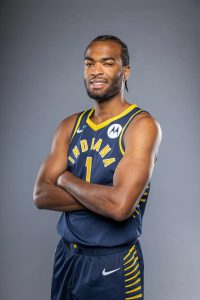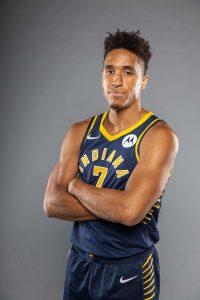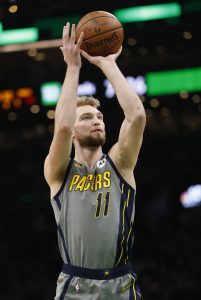The Pacers entered the offseason at an interesting crossroads. While franchise cornerstones like Victor Oladipo, Myles Turner, and Domantas Sabonis remained under contract, most of the rest of the team’s rotation headed to free agency this summer. Of the seven players who played the most minutes for Indiana in 2018/19, five were unrestricted free agents.
Re-signing most of those players would’ve been the safe move. After all, the Pacers were comfortably a top-five team in the East last season, and their ceiling could get even higher once Oladipo gets healthy, as Turner and Sabonis continue to improve.
Instead though, not one of those five key free agents returned to the Pacers on a new deal. In some cases, there was good reason for that — Darren Collison announced his retirement, while Tyreke Evans was dismissed and disqualified from the NBA for at least two years as a result of a drug violation. But it was still a little surprising to see so much turnover in Indiana.
The Pacers did well to fill out their roster around their top players through a series of free agent signings and trades, but there’s still a degree of uncertainty surrounding the franchise heading into the 2019/20 season.
This is a well-coached team that still has plenty of talent on its roster, but with so many reliable veterans no longer in the mix, there will be a lot riding on the players the Pacers brought in to replace them.
Key offseason losses:
While neither player was a star, Collison and Cory Joseph had performed admirably handling point guard duties for the Pacers for the past two seasons. Collison, the starter, knocked down 43.9% of his three-point attempts in his two years as a Pacer, and distributed the ball well, averaging a career-high 6.0 assists per game in 2018/19. Those numbers made it all the more surprising that he decided to call it a career in June at the age of 31.
Joseph, meanwhile, was one of the only NBA players to appear in all 82 games in each of the last two seasons, and has been one of the league’s most reliable backup point guards during that stretch, particularly on the defensive end. His play earned him a three-year, $37MM+ deal from the Kings which Indiana was presumably unwilling to match.
The Pacers’ frontcourt losses were perhaps even more impactful, as Bojan Bogdanovic and Thaddeus Young both departed in free agency, securing nice paydays in Utah and Chicago respectively. Bogdanovic was perhaps overextended down the stretch and in the postseason as Indiana’s go-to play-maker with Oladipo out, but he still enjoyed a career year, establishing new career highs in PPG (18.0), FG% (.497), and 3PT% (.425), among other categories.
As for Young, he had been a nice fit as the Pacers’ starting power forward over the last three years. His offensive numbers were modest (11.8 PPG on .513/.346/.597 shooting), but his versatility and toughness were a major asset on defense — he had the athleticism to guard scorers on the perimeter and the length to challenge them inside as well.
Evans was inconsistent during his lone season as a Pacer, though he was one of the club’s few players capable of creating his own shot on offense. Indiana may miss Wesley Matthews more — he provided the team with some much-needed floor spacing after Oladipo went down.
Key offseason additions:
The Pacers made a splash early in free agency this year, agreeing to a sign-and-trade deal with the division-rival Bucks for Brogdon. Besides costing Indiana a lottery-protected first-round pick and a pair of future second-rounders, Brogdon also represents the biggest free agent expenditure in team history, on a four-year, $85MM deal.
At times last season, Brogdon looked like the second-best player on a 60-win team, so it’s no surprise that he did well on the open market. The two big questions facing him this season will be whether he can stay healthy (he has a history of foot problems) and whether he can maintain anything close to his .505/.426/.928 shooting line as his usage rate increases.
 The Pacers’ trade for T.J. Warren was one of the most widely praised deals of the summer. Considering the team also secured three second-round picks in addition to Warren in exchange for just $1.1MM in cash, that move has to be considered a big win even if the veteran forward is a disappointment in Indiana. His offensive numbers for Phoenix were certainly promising, but scoring empty points for a lottery team is different than playing a key role on a playoff contender. Indiana will want to see improvements from him on the defensive end of the court.
The Pacers’ trade for T.J. Warren was one of the most widely praised deals of the summer. Considering the team also secured three second-round picks in addition to Warren in exchange for just $1.1MM in cash, that move has to be considered a big win even if the veteran forward is a disappointment in Indiana. His offensive numbers for Phoenix were certainly promising, but scoring empty points for a lottery team is different than playing a key role on a playoff contender. Indiana will want to see improvements from him on the defensive end of the court.
Jeremy Lamb and Justin Holiday will also join the Pacers on the wing, having signed as free agents. Lamb, who was Charlotte’s second-leading scorer last season with a 15.3 PPG, was a nice pickup, though Holiday’s one-year, $4.77MM deal makes him the more low-risk addition of the two. Indiana will want to see Holiday improve upon the .378 FG% he posted over the last two years in Chicago and Memphis.
Finally, one of the Pacers’ most interesting additions of the offseason came on draft night, when the club used its first-round pick to nab big man Goga Bitadze. His skill set seemingly overlaps with Sabonis’ and Turner’s, which immediately led to trade speculation, but the Pacers have said they simply targeted the best player available. Plus, if Sabonis and Turner are both starting, Bitadze makes sense as a depth piece. If he develops quickly and proves he deserves regular minutes, it will be interesting to see how the Pacers handle their potential frontcourt logjam.
Outlook for 2019/20:
While they flew under the radar to some extent during a wild 2019 offseason, the Pacers underwent some significant roster changes and have an interesting season ahead of them. It’s not out of the question that Indiana finishes as high as No. 3 in the Eastern Conference. It also wouldn’t be a total shock if the club misses the postseason altogether.
Oladipo’s recovery timetable – and how he looks upon returning – will go a long way toward determining where the Pacers finish in 2019/20, but even without the former All-NBA guard in the lineup, this team should have enough talent to hang onto a playoff seed. The safe bet is that Indiana ultimately lands somewhere in the 5-7 range in the East.
Salary information from Basketball Insiders was used in the creation of this post. Photos courtesy of USA Today Sports Images.
 Standard contracts:
Standard contracts:
 The Pacers’ trade for
The Pacers’ trade for 